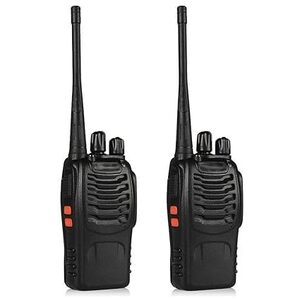The Ultimate Guide to Choosing the Best Walkie Talkie for Your Needs
Cuerpo
Walkie talkies are versatile communication tools that can be essential for a variety of activities, from outdoor adventures and professional use to security and emergency situations. With numerous models and features available, selecting the best walkie talkie for your needs can be overwhelming. This guide will help you navigate through the options and choose the perfect walkie talkie for your requirements.
1. Understand Your Needs
Before diving into technical specifications, it’s crucial to determine what you need the walkie talkie for. Consider the following scenarios:
- Outdoor Activities: For activities like hiking, camping, or hunting, you’ll need a walkie talkie with long range and durability.
- Professional Use: In sectors like construction or event management, you may require features such as hands-free operation and clear audio.
- Security: For security personnel, walkie talkies with encrypted communications and emergency alert functions are important.
- Casual Use: For family outings or recreational use, ease of use and affordability may be the priority.
2. Range and Coverage
One of the most important factors to consider is the range of the walkie talkie. The range can vary greatly depending on the environment:
- Urban Areas: Buildings and other obstacles can reduce the effective range. Look for models with a range of at least 1-2 miles.
- Open Terrain: For open fields or forests, choose walkie talkies with a range of up to 10 miles or more.
Keep in mind that manufacturer claims about range are often under ideal conditions, so real-world performance may differ.
3. Frequency and Channels
Walkie talkies operate on different frequencies and channel configurations:
- FRS (Family Radio Service): These are designed for short-range, low-power communication and are license-free. They are ideal for casual use.
- GMRS (General Mobile Radio Service): These offer longer range and higher power but require a license. They are suitable for more demanding communication needs.
- UHF (Ultra High Frequency): Good for communication in built-up areas as they penetrate buildings better.
- VHF (Very High Frequency): Better suited for open spaces where long-range communication is needed.
4. Battery Life
Battery life can be a critical factor, especially for extended use:
- Rechargeable Batteries: Offer convenience and cost-effectiveness in the long run. Look for models with a long battery life, typically ranging from 12-24 hours on a single charge.
- AA or AAA Batteries: Useful for emergency situations where recharging may not be feasible. Ensure the walkie talkie supports standard battery types.
5. Durability and Build Quality
For rugged environments or outdoor activities, durability is essential:
- Water Resistance: Check for models with an IP rating that indicates resistance to water and dust.
- Shock Resistance: A walkie talkie with a sturdy build and shockproof features will withstand drops and rough handling.
6. Features and Functionality
Consider additional features that can enhance usability:
- Weather Alerts: Some walkie talkies come with NOAA weather channels to provide weather updates.
- Hands-Free Operation: Features like VOX (voice-activated transmission) allow for hands-free communication, which is useful for multitasking.
- Privacy Codes: These prevent interference from other users on the same channel.
- Display and Controls: A clear display and intuitive controls make operation easier, especially in low-light conditions.
7. Ease of Use
Choose a walkie talkie that is easy to operate:
- User-Friendly Interface: Simple controls and a straightforward interface make it easier to use, especially for beginners.
- Ergonomics: Consider the size and weight of the device, ensuring it’s comfortable to hold and carry.
8. Budget
Walkie talkies come in a wide price range:
- Budget Models: Generally have basic features and shorter range but are suitable for casual use.
- Mid-Range Models: Offer better range, durability, and additional features like hands-free operation.
- High-End Models: Include advanced features, long-range capabilities, and superior build quality. Ideal for professional or heavy-duty use.
Conclusion
Choosing the best walkie talkie involves evaluating your specific needs, considering the range, battery life, and additional features, and ensuring durability and ease of use. By assessing these factors, you can select a walkie talkie that will effectively meet your communication needs, whether for professional use, outdoor adventures, or casual use.













Comentarios